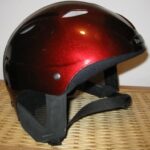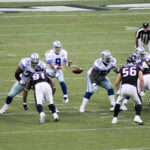Probably one of the most recognizable pieces of athletic equipment is the football helmet. The decals and stripes on this piece of equipment is a colorful and interesting device. The easiest way to identify a football team at most levels is how their helmet is decorated. Football helmets have a main purpose and that is to protect your head. There has been an evolution of the helmet over the years that is interesting. In the early days of the sport, there was no head gear to protect the players. In the late 1800s, the earliest form of head protection were two pads held together by leather straps to protect the ears and a device that looked like a shoe horn with leather straps to protect the nose. The football headgear eventually consisted of padding covering the crown of the head and the ears. These helmets often resembled the leather flight helmet that Snoopy wore when he was fighting the Red Baron. Here is a little look at the first leather helmets and how they evolved to the ball of plastic, steel, and padding that we recognize today.
Around the turn of the 20th century, someone developed a helmet that resembles the current boxing head gear. it was made of soft leather and had padding to protect the ears and crown of the skull. It’s main purpose was to reduce the chances of the skull being fractured while playing football. The father of the football helmet is considered to be Lafayette university Halfback George “Rose” Barclay who fashioned some straps and some cups that fit over the ears to prevent the development of “cauliflower ears”. These straps eventually included a padded leather strap that went around the crown of the head as seen in a Popular Mechanics photograph. This also protected the temple of the skull which is vulnerable to cleats fracturing it if left unguarded.
In the following decade the whole head became protected. These new helmets, like their predecessors, did not include a chin strap. This would make it easy for the head gear to be ripped from the head. In those days there were no rules that required the wearing of protective head gear, however, the helmet still evolved and became more widely used. In the 1920s more padding was added to help prevent concussions and there were holes in the ear covering to aid in hearing. A great example of what these helmets looked like can be seen in the George Clooney film “Leatherheads”. In the 1930s, the leather helmets were made with harder leather to provide better protection. Teams at this time started to feature helmets in team colors. Another innovation that is seen to this day came from Princeton University Coach Fritz Crisler. He outfitted his teams with helmets made of a “winged Construction” that were black in color and the “wings” and three leather supporting straps in orange. Crisler came up with this idea as a way to help Quarterbacks help identify receivers and this gave the appearance of a tiger with its ears pinned back and ready to attack. When he left Princeton for the University Michigan in 1938 he took the look with him and adapted the Wolverines’ school colors of Maze and Blue. Princeton abandoned this look after Crisler left but brought it back in 1998. The winged look on the helmet has become synonymous with Michigan football and many of the school’s other teams that require helmets have adopted the look.
By the 1940s the helmet had become mandatory in virtually all levels of football. They construction didn’t change much until the end of the decade. The Cleveland (now St, Louis and formerly Los Angeles) Rams became the first team to use an identifiable logo when they painted ram horns on the sides of the helmets. The biggest innovation came in a new material in the construction of the helmets, plastic. The John T. Riddell Company developed the suspension helmet for the troops during World War II and also a plastic suspension helmet for paratrooper training. The first plastic helmets were made of a poor design and were not able to take blows to the heads too well and often cracked. This led the NFL to ban plastic helmets for a period of time. George Halas, often considered the “Father of Professional Football” helped Riddell work on improving the design and find stronger plastics to make the helmets safer. They still used the suspension system that was developed by Riddell. The suspension helmet is a helmet with a ring that is sized for a proper fit that is attached to the helmet by rivets. The suspension helmet only consisted of padding for the jaws and was designed to deflect blows to the head with little or no feeling to the person wearing the helmet.
By the late 1950s a new addition started appear on football helmets, the face guard (or face mask). One of the first face masks were strips of clear Lucite that wrapped around the front of the helmet and covered the mouth and nose of the wearer of the helmets. The problem these face masks had were that they frequently shattered upon impact. Cleveland Browns Quarterback Otto Graham was one of the first to advocate the wearing of the face mask. His first mask was the Lucite strip. Graham eventually sported a face mask made of a shatter resistant plastic that consisted of a single bar. The main purpose of the single bar was to protect the mouth. Many players wore this single bar mask or a double bar. Johnny Unitas helped make this face mask design popular. An incident involving the hard and blatant hit that severely broke the jaw and damaged the face of Drake University player Johnny Bright , in what is often referred to as the “Johnny Bright Incident” against Oklahoma A&M; (now Oklahoma State) helped the NCAA mandate facial protection on all helmets by the end of the decade. The single bar and double bar plastic face masks offered minimal protection of the face. Schutt Manufacturing became the leader in face mask manufacturing when they offered “cage-styled” face masks that initially bolted directly to the helmet. Eventually Schutt came up with face guards that were attached with plastic clips that were held to the helmet with industrial strength screws. The Schutt masks were a favorite among linemen and defensive players because of the full facial protection that was offered with these face masks compared to the single and double bars. By the 1980s, with the exception of Joe Theismann and and Jim Plunkett who played Quarterbacks and wore the single and double bar face masks respectively, the only position players who wore the double bar and single bar face masks were kickers and punters. Most players were opting for the cage style masks because of their durability and better face protection.
In the 1970s padding was added to helmets to help absorb the shock from blows to the head. The padding was
proven to be a better defense against concussions than the suspension rings and the suspension helmet had virtually disappeared from football by the end of the 1970s. Riddell came up with a strip of sponge like padding that clipped inside the helmet and could be adjusted to properly fit the football player’s head. Mac Gregor Sporting Goods and Kelly Manufacturing both made football helmets that were made of clear plastic and the decals were placed on the inside of the helmet and then painted over. The padding was inserted after the decals and paint were added to the helmet and then the face mask was added. A new feature to helmets that began to appear in the 70s was the addition of color to the face masks. The standard color of face masks at the time was Grey for everybody. The Kansas City Chiefs began using solid white colored face masks in 1974 using the theory that the white would make an opponent’s hand more visible if it were on the face mask and would result in more face mask penalties being called against their foes. That same year the San Diego Chargers came out with a new look, abandoning their white helmets for new blue helmets with yellow face masks. That same year, a new league formed called the World Football League. Two teams, the Detroit Wheels and the Philadelphia Bell featured these new fangled colored face masks. Detroit wore yellow while Philadelphia wore blue. By the end of the decade many professional, college, and high school teams were switching over to the colored face masks.
In the 1980s, the National Collegiate Athletics Association implemented rules to help further protect the players and reduce injuries. These rules included making head to head intentional contact illegal, banning the spear blocking, and the banning of the plastic single and double bar face masks. The single and double bar face masks were directly bolted to the helmet and were difficult to remove in the event of a head or neck injury and offered minimal protection of the face as opposed to the cage style masks that were attached by clips, making it easier to remove in the event of said injuries, and offered better protection of the face. The introduction of stronger alloys allowed the face masks to be of a stronger construction and less likely to bend upon hard impacts.
When the 1990s rolled around these stronger alloys were the standard of all face mask construction. Riddell came up with a new face mask made of ABS plastic. These were made of a better plastic than their single and double bar predecessors but also had sharp edges that caused cuts on the hands of tacklers and on the faces of the player wearing these face masks. By the end of the decade, they had all but disappeared from the game. Another innovation in the 1990s was seen on the helmets of Buffalo Bills’ Defensive Back Mark Kelso and San Francisco 49ers’ Offensive Lineman Steve Wallace wore and exterior device called the “Pro Cap” which was manufactured by the company Protective Sports Equipment to reduce concussions. Both Kelso and Wallace had received multiple concussions and chose to wear this rather unorthodox looking device over the outer shell of their helmets to extend their careers. This decade saw several players, such as Troy Aikman of the Dallas Cowboys and Steve Young of the San Francisco 49ers go public with the multiple concussions they had received and continued to receive while playing football. Manufacturers began scrambling to find ways to improve the way the heads were protected. They started off by improving the padding in their existing designs and then eventually in the early part of the 2000s they came with new helmet designs.
Riddell came out with the Revolution helmet in 2002. One of the most famous players to begin wearing the helmet was Peyton Manning, Quarterback of the Indianapolis Colts. The Revolution had a more rounded shell and the front extended to cover the jaw. The new design was laughed at and many players did not want to wear this awkwardly looking helmet. Manning began wearing this helmet in 2002 after he had suffered a broken jaw near the end of the 2001 season. The Revolution offered additional padding and shock absorption. The flaws that Revolution has had include the bulky bottom screws that attach the bottom part of the face mask that made it more difficult to remove if needed and the helmet is heavier than the conventional designs. Schutt answered Riddell’s Revolution with improving the design of their popular and existing Pro Air helmet and the introduction of their DNA model helmet. In 2007, Schutt introduced the ION helmet. The ION has padding that is inflatable to ensure a better and more proper fit and the biggest feature of the ION is the face mask. The face mask is screwed to the top of the helmet and then there is a clip on the sides of the helmet to secure the face mask to the helmet and to provide shock absorption.
In 2004 Doctor Vincent Ferrara founded the company Xenith. Ferrara was a former Quarterback for the Harvard University football team and devoted his time in researching was to help better protect the head. The product of his research was a new helmet called the Xenith X1. The X1 helmet combines the suspension helmet and the padded helmet. The helmet is fitted by adjusting the chin strap which is attached to sizing cables that adjust around the head of the person wearing the helmet. The padding is shock absorbing and collapses upon impact. The collapsing causes air to be released from the pad and reduces the energy of the impact. As of 2009 there are several professional players and high school teams that use the X1. The Billings Outlaws of the Indoor Football League as adopted the X1 as their official helmet. While no helmet can prevent all concussions, the manufacturers Riddell, Schutt, and Xenith are making great strides to help reduce the amount of concussions football players receive.
Another new innovation in football helmet technology comes from Schutt and is called “Hot Head”. Hot Head is a sensor that fits inside the helmet and it monitors the player’s body temperature. The data is transmitted to a PDA on the sideline that a trainer or coach can monitor. When the body temperature reaches a critical rate, the Hot Head sends an alarm to the PDA and thus they can remove the player from the field and have them cool down before any potentially permanent or fatal damage can occur to the player. This new technology has come to light recently especially after several incidents involving athletes participating in football having fallen to heat casualties. One incident involved Kentucky high school coach, David Stinson, being indicted and tried for the negligent homicide of a player on his team. Also the death of Minnesota Vikings Offensive Lineman Korey Stringer during training camp in 2001, and the lawsuit by his widow against Riddell that followed, helped bring about the need for such a product. Another technological innovation is the use of radio receivers in the helmets of some players in the NFL. The transmitters enable players, especially Quarterbacks, to be able to hear the plays being called from the sidelines and not having to worry about not being able to see signals and not able to hear due to crowd noise. This innovation is hardly new, Paul Brown, then Coach of the Cleveland Browns, tried this with Otto Graham in the 1950s but abandoned this due to interference from taxi cab dispatch radios and the fact that the radios were bulkier at that time compared to now. Riddell has come out with the Revolution IQ H.I.T.S. (Head Impact Telemetry System) which measures the impact via sensors and transmitted to a PDA on the level of force and severity of the impact from a blow suffered to the head as well as the number of hits the head and helmet have taken. This helpful information can be used to determine if a player can continue playing after an impact to the head. The United States Army has fielded similar technology with the combat helmets currently on the heads of troops in the Middle east.The football helmet has now developed a new and additional purpose, to relay information and to save lives through technology.
In recent years some college teams have adopted the use of wearing two or more different colored helmets. Some, like Washington State University, will alternate them by wearing one color for home games and the other for road games. Oregon has four different helmets in their uniform line up and combined with the many different jersey and pant combinations, that gives them a different look for just about every game they play. The Jacksonville Jaguars of the NFL introduced a color shifting helmet in 2009. depending on how the light is hitting the helmet at a person’s point of view, the helmet can appear to be black or teal. Many teams have their helmets painted with an automotive quality finish with metallic flakes to give it a shinier appearance and some teams have come up with some creative and unique designs to sport on their helmets. The Denver Broncos Came out with a Midnight Blue colored helmet with a space age looking horse head and a triangular stripe in 1997. Many teams followed suit. Some teams like Alabama, Cleveland Browns, Penn State, USC, and LSU have kept a traditional look to their helmets but have adapted to the newer and safer designs.
There is no telling on what will be on the heads of football players 20 years from now but if the evolution continues the way it has for the last 100 years, we can see a much different look on the gridiron. No matter what color or decal and stripe design is on the helmet, the main job of the helmet has been and will always be to protect the head. Research will continue to find ways to better protect the most valuable piece of equipment of a football player, the head.





